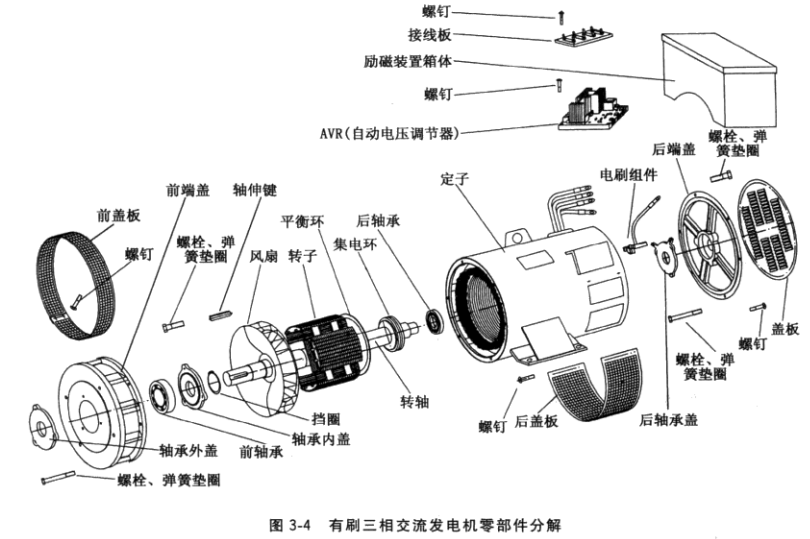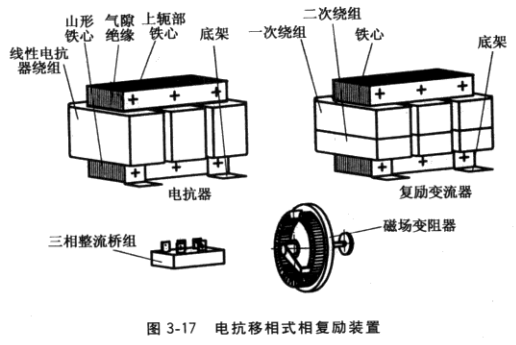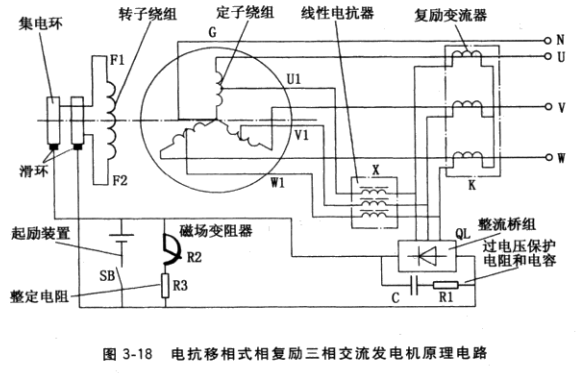Basic structure
The generator is based on the basic structure of the brushed three-phase alternator shown in Figure 3-4 , and is equipped with a reactive phase shift excitation device (see Figure 3-17) , which includes a linear reactance with an adjustable air gap. , compound excitation converter, three-phase rectifier bridge group, adjustable varistor and overvoltage resistance and capacitance protection components.


(1) Linear reactor. The core of the mountain-shaped punching piece, the upper yoke core, the winding and the air gap insulation are stacked.
(2) Compound excitation converter. The core, the primary winding and the secondary winding are formed by a stack of mountain-shaped punching pieces and a flat-shaped punching piece.
(3) Three-phase rectifier bridge group. It is a three-phase bridge assembly and can also be assembled from six silicon rectifier components. The output current level of the rectifier bridge group should be greater than 3 to 4 times the rated excitation current of the generator rotor.
(4) Magnetic field varistor. Used to shunt the generator excitation current to set the generator terminal voltage.
2. Working principle
The principle circuit of the uncontrollable reactance phase shifting phase compound excitation three-phase alternator is shown in Figure 3-18. The linear reactor is connected to the generator stator three-phase winding taps U1, V1, W1. It can be seen from the figure that the voltage component of the AC side excitation current is supplied by the stator winding tap voltage through the linear reactor, and the generator load current is supplied by the compound excitation current to the current component of the AC side excitation current, and the two are geometrically synthesized through the rectifier bridge. After the group is rectified, the excitation current is supplied to the rotor winding of the generator to establish the main magnetic field of the rotor. The function of the linear reactor is to make the phase of the current component supplied by it to be shifted by about 90 electrical degrees, and this current component is supplied to the excitation current required to maintain a certain terminal voltage when the generator is idling. Compound excitation effect of the converter is the phase of the load current phase of the current supplied by the generator points that the same phase, which current value and a negative linear relationship between plant, which is provided by the armature reaction demagnetization when the compensated load The excitation current required for the effect.

For departments and places with high precision voltage requirements, a shunt controllable (automatic) voltage regulator can be configured on the basis of uncontrollable reactance phase shifting phase compound excitation.
Hard turbine speed door: set energy-saving insulation and efficient wind environmental seal in a new metal industrial doors , opening speed of up to 1.5meters per second , For applications that require frequent rapid opening of the logistics channel , Insulation thickness 0.7mm aluminum door intermediate polyurethane foam , total thickness 40mm door wide 185mm per meter weight 1.63KG, Having good thermal insulation and light weight impact strength and other characteristics , wind rating of greater than 12 and theft , The door is suitable for indoor and outdoor fast-track logistics and production , The door type for enterprises save a lot of energy due to air flow generated loss than ordinary industrial sliding doors shutter doors save energy about eighty percent , Rapid opening and closing of the door so that enterprises in the rotational speed of the production and logistics of the door is greatly improved enterprise logistics and production must pass through the channel selection and its use is directly related to the efficiency of production and logistics , This product has high reliability , practicality and easy operation and quick fix for me , Drive control using a stable energy-effcient and accurate hard to guarantee fast and reliable operation of the door system the door to ensure trouble-free operation every year more than 250,000 times
Turbine Hard High Speed Door, high speed spiral doors, aluminum high speed door, Aluminum Rapid Door, Aluminum Fast Door
SHENZHEN HONGFA AUTOMATIC DOOR CO., LTD , https://www.hongfahss.com